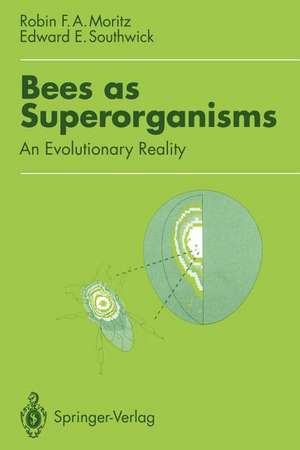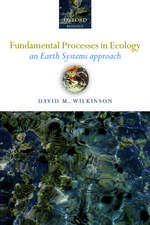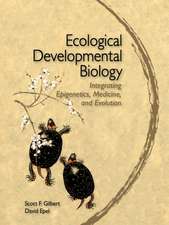Bees as Superorganisms: An Evolutionary Reality
Autor Robin Moritz, Edward E. Southwicken Limba Engleză Paperback – 20 dec 2011
Preț: 786.84 lei
Preț vechi: 959.56 lei
-18% Nou
Puncte Express: 1180
Preț estimativ în valută:
150.56€ • 157.20$ • 124.61£
150.56€ • 157.20$ • 124.61£
Carte tipărită la comandă
Livrare economică 04-18 aprilie
Preluare comenzi: 021 569.72.76
Specificații
ISBN-13: 9783642846687
ISBN-10: 3642846688
Pagini: 416
Ilustrații: XVI, 395 p.
Dimensiuni: 155 x 235 x 27 mm
Greutate: 0.58 kg
Ediția:Softcover reprint of the original 1st ed. 1992
Editura: Springer Berlin, Heidelberg
Colecția Springer
Locul publicării:Berlin, Heidelberg, Germany
ISBN-10: 3642846688
Pagini: 416
Ilustrații: XVI, 395 p.
Dimensiuni: 155 x 235 x 27 mm
Greutate: 0.58 kg
Ediția:Softcover reprint of the original 1st ed. 1992
Editura: Springer Berlin, Heidelberg
Colecția Springer
Locul publicării:Berlin, Heidelberg, Germany
Public țintă
ResearchDescriere
The honeybee (Apis melli/era L. ) is one of the better studied organisms on this planet. There are plenty of books on the biology of the honeybee for all, the scientist, the beekeeper, and the layman. In view of this flood of publications one is tempted to ask: why does it require another one? The answer is simple: a new one is not required and we do not intend to present a new book on "the honeybee". This would really just add some more inches to the already overloaded bookshelf without sub stantial new information. Instead, we intend to present a book on the honeybee colony. This of course immediately releases the next question: so what is the difference? Although the difference may look insignificant at first glance, we try to guide the reader with a fundamentally different approach through the biology of honeybees and eusocial insect societies in general. The biology of individual colony members is only addressed when it is necessary to explain colonial mechanisms, and the colony as a whole, as a biological unit, which is the main focus of this treatise. Both of us felt that all current textbooks on bee biology put too much emphasis on the individual worker, queen or drone in the colony. Often it is com pletely neglected that the colony is a very significant (if not the most significant) biological structure in bee biology.
Cuprins
1 What Is a Superorganism?.- 1.1 From Cells to Metazoan Organisms.- 1.2 What Makes a Social Group a Superorganism?.- 1.3 Diversity of Superorganisms.- 1.3.1 Termites.- 1.3.2 Superorganismic Ants.- 1.3.3 Bees.- 1.3.4 The Naked Mole Rat.- 1.4 What Not to Expect from Superorganisms.- 2 Evolution of Superorganisms.- 2.1 From Solitary Individuals to Superorganisms: The Theories.- 2.1.1 Darwin’s Dilemma.- 2.1.2 Individual Selection Models.- 2.1.2.1 Kin Selection.- 2.1.2.2 Assured Fitness Returns.- 2.1.2.3 Parental Manipulation.- 2.1.2.4 Mutualism and Reciprocal Altruism.- 2.1.2.5 Testing Theories.- 2.1.3 Group Selection.- 2.1.3.1 Classical Group Selection.- 2.1.3.2 Competitive Group Selection.- 2.1.3.3 Colony-Level Selection.- 2.1.3.4 Testing Theories of Group Selection.- 2.2 From Solitary Individuals to Superorganisms: The Evidence.- 2.2.1 Sociality in Bees.- 2.2.2 Solitary and Subsocial Bees.- 2.2.2.1 Megachile rotundata: The Individualist.- 2.2.2.2 Carpenter Bees: The Hierarchists.- 2.2.3 Primitively Social Bees.- 2.2.3.1 Exoneura bicolor Smith: The Mutualist.- 2.2.3.2 Halictine Bees: Getting Social.- 2.2.3.3 Bombus: Controlling Environment.- 2.2.4 Superorganismic Bees.- 2.2.4.1 Stingless Bees.- 2.2.4.2 Evolution Within the Genus Apis.- 3 Physiology.- 3.1 Development.- 3.1.1 From Egg to Adult.- 3.1.2 Caste.- 3.1.3 Birth, Aging, and Death of a Superorganism.- 3.1.3.1 Birth.- 3.1.3.2 Aging and Age Variation.- 3.1.3.3 Death and Immortality.- 3.2 Glands and Secretions.- 3.2.1 Endocrine System.- 3.2.2 Exocrine System.- 3.3 Feeding and Digestion.- 3.3.1 Nutrition.- 3.3.2 Food Exchange and the Meniscus Effect.- 3.3.3 Pollen Stores.- 3.3.4 Making Honey.- 3.4 Respiration.- 3.4.1 Respiration in Individuals.- 3.4.2 Respiration in Colonies.- 3.5 Circulation.- 3.5.1 Haemolymph Circulation.- 3.5.2 Circulation in the Colony.- 3.6 Colonial Excretion and Water Balance.- 3.7 Metabolic Physiology.- 3.7.1 Temperature Control.- 3.7.1.1 Cooling.- 3.7.1.2 Heating.- 3.7.1.3 Maintenance of Nest Temperature.- 3.7.1.4 Optimal Environmental Temperature and Nest Choice.- 3.7.2 Mass-Metabolism Relationships and Colony Fitness.- 3.7.3 Seasonal Relationships.- 3.8 Neurophysiology.- 3.8.1 Vision.- 3.8.2 Chemical Sense.- 3.8.3 Acoustic and Mechanical Reception.- 3.8.4 Special Sense, Learning and Integration.- 3.9 Muscle Function.- 3.9.1 Locomotion and Flight.- 3.9.2 Stinging and Biting.- 3.10 Circadian Rhythms and Sleep.- 3.10.1 Cyclic Metabolism.- 3.10.2 Cyclic Locomotion.- 3.10.3 Cyclic Ventilation.- 3.10.4 Sleep.- 4 Communication Network of the Superorganism.- 4.1 The Analysis of Communication Networks.- 4.2 Division of Labour.- 4.3 Food Procurement and Temperature Regulation.- 4.3.1 The Search for Food.- 4.3.1.1 Individual Search Pattern of a Scout.- 4.3.1.2 Foraging a Patch of Flowers.- 4.3.2 Communication Mechanisms.- 4.3.2.1 Round Dance.- 4.3.2.2 Waggle Dance.- 4.3.2.3 Acoustic Signals.- 4.3.2.4 Odour Signals.- 4.3.2.5 Dorsoventral Abdominal Vibration (DVAV) Dance.- 4.3.3 Central Food Handling and Social Integration.- 4.3.3.1 Amoeboid Foraging Pattern.- 4.3.3.2 Nectar Storage.- 4.3.3.3 Queueing.- 4.3.3.4 Comb Utilization.- 4.3.3.5 Water Handling.- 4.4 Search for Housing.- 4.4.1 Nest Site Selection.- 4.4.2 Swarm Orientation.- 4.4.3 Migration.- 4.5 Pheromones.- 4.5.1 Superorganismal Control.- 4.5.2 Queen Pheromones Inside the Nest.- 4.5.2.1 Queen Retinue Behaviour.- 4.5.2.2 Colony Stabilization and Ovary Suppression in Workers.- 4.5.3 Queen Pheromones Outside the Nest.- 4.5.3.1 Swarm Attraction.- 4.5.3.2 Sex Attractant.- 4.5.4 Worker Pheromones.- 4.5.4.1 Orientation.- 4.5.4.2 Colony Defence.- 4.5.5 Other Pheromones and Odours.- 4.6 Learning.- 4.7 Social Intelligence and Network Analysis.- 4.7.1 Social Intelligence.- 4.7.2 Network Analysis.- 5 Ecology.- 5.1 Demography of Natural Populations.- 5.1.1 Life History Strategies.- 5.1.1.1 Sessile Phase.- 5.1.1.2 Mobile Phase.- 5.1.1.3 Life Cycle.- 5.1.2 Spatial and Temporal Distribution.- 5.1.2.1 Colony Defence.- 5.1.2.2 Removal of Debris and the Dead.- 5.1.2.3 Home Range.- 5.1.2.4 Mating Distance.- 5.1.2.5 Overdispersion of Colonies.- 5.1.3 Distribution of Honeybees.- 5.1.4 Intracolonial Structure.- 5.2 Community Structure.- 5.2.1 Plant/Bee Symbioses.- 5.2.1.1 Foraging and Pollination.- 5.2.1.2 Energy Flow and Material Turnover.- 5.2.1.3 Honeydew.- 5.2.2 Selective Forces and Diversity.- 5.2.2.1 Intraspecific Competition.- 5.2.2.2 Interspecific Competition Among Superorganisms.- 5.2.2.3 Competition with Individual Organisms.- 5.2.3 Diseases, Parasites, and Predators.- 5.2.3.1 Superorganism Pathology.- 5.2.3.2 Specific Examples.- 5.3 Superorganism Size.- 5.3.1 Temporal Variation in Group Size.- 5.3.1.1 Environmental Determinants of Group Size.- 5.3.1.2 Intrinsic Determinants of Group Size.- 5.3.2 Fitness and Group Size.- 5.3.2.1 r and K Selection.- 5.3.2.2 Queen Fecundity.- 5.3.2.3 Periods of Dearth.- 5.3.2.4 Defence and Group Size.- 5.3.3 Optimization Model of Group Size.- 5.4 Ecological Impact of Superorganismic Honeybees.- 5.4.1 Natural Areas.- 5.4.2 Agricultural Land.- 6 Reproduction.- 6.1 Individual Reproduction.- 6.1.1 Sexual Reproduction.- 6.1.1.1 Sex Determination and Sex Ratios.- 6.1.1.2 The Queen.- 6.1.1.3 The Drones.- 6.1.1.4 Mating Behaviour.- 6.1.2 Parthenogenesis.- 6.1.2.1 Production of Drones by the Queen.- 6.1.2.2 Production of Drones by Workers.- 6.1.2.3 Production of Females by Workers.- 6.1.3 Negative Reproduction.- 6.1.3.1 Brood Cannibalism.- 6.1.3.2 Worker Policing.- 6.2 Colonial Reproduction.- 6.2.1 The Seasonal Development of a Colony.- 6.2.1.1 The Yearly Life Cycle in a Temperate Climate.- 6.2.1.2 Somatic Growth and Worker Force Dynamics.- 6.2.2 Sexual Reproduction of Colonies.- 6.2.2.1 Production of Gametes and the Zygote.- 6.2.2.2 The Sex of a Colony.- 6.2.3 Asexual Reproduction of Colonies.- 6.2.3.1 Swarming Behaviour.- 6.2.3.2 How Many Swarms?.- 6.2.3.3 The Primary Swarm: Join the Old or the New Queen?.- 6.2.3.4 The Afterswarms: Join the Super or Half Sister?.- 6.2.3.5 Is Swarming = Colony Budding?.- 7 Genetics.- 7.1 Gene Expression vs Genotype Expression.- 7.1.1 The Limbs and the Stomach Model.- 7.1.2 Intraorganismic Genetic Variation — the Principal Difference.- 7.1.3 Gametes — the Functional Difference.- 7.2 Genetic Basis of Honeybees.- 7.2.1 Male Haploidy.- 7.2.2 Sex Determination.- 7.2.2.1 The Sex Locus.- 7.2.2.2 Diploid Males.- 7.2.3 The Terminology Problem.- 7.2.3.1 What Is a Generation?.- 7.2.3.2 Who Is Who in a Honeybee Family?.- 7.3 Genetic Variation in Honeybee Colonies.- 7.3.1 Origins for Intracolonial Genetic Variance.- 7.3.2 Measures of Genetic Relationship.- 7.3.2.1 Coefficients of Relationship Based on Pedigree Information.- 7.3.2.2 Relationships in Natural Populations.- 7.3.2.3 Weighted Coefficients of Relatedness.- 7.3.3 Genetic Relationship Between the Members of a Colony.- 7.3.3.1 Relationship Between Queen and Her Offspring.- 7.3.3.2 Relationship Between Workers and Drones.- 7.3.4 Relationship Between Groups.- 7.3.4.1 Average Individual Relationship.- 7.3.4.2 Group Relationship.- 7.4 Quantitative Genetics.- 7.4.1 The Problems in Analyzing Social Characters.- 7.4.2 The Classical Parameters.- 7.4.2.1 Repeatability.- 7.4.2.2 Selectability.- 7.4.2.3 Non-Linear Interactions.- 7.4.3 Similarities Between Colony Members.- 7.4.3.1 Genetic Covariance Among Workers.- 7.4.3.2 Genetic Covariance Among Drones.- 7.4.3.3 Covariance Between Queen and Offspring.- 7.4.3.4 Covariance Between Drone and Offspring.- 7.4.3.5 Covariance Between Mid-Parent and Offspring.- 7.4.4 Similarities Between Related Colonies.- 7.4.4.1 Worker Effects.- 7.4.4.2 Combined Effects.- 7.4.5 Selection Index.- 7.4.6 Empirical Examples.- 7.4.6.1 Analysis of Individual Characters.- 7.4.6.2 Analysis of Social Traits of Small Worker Groups.- 7.5 Behavioural Genetics.- 7.5.1 Analysis of Individual Behaviour.- 7.5.1.1 Learning Behaviour.- 7.5.1.2 Trophallactic Behaviour.- 7.5.1.3 Reproductive Dominance.- 7.5.2 Analysis of Social Behaviour.- 7.5.2.1 Hoarding Behaviour.- 7.5.2.2 Hygienic Behaviour.- 7.5.2.3 Defensive Behaviour.- 7.5.2.4 Division of Labour.- 7.6 Population Genetics.- 7.6.1 The Effective Population Size of Superorganisms.- 7.6.2 Polymorphisms in Nuclear Genome.- 7.6.2.1 Isozyme Polymorphism.- 7.6.2.2 Molecular DNA Markers.- 7.6.3 Inbreeding.- 7.6.3.1 Inbreeding and Practical Breeding Schemes.- 7.6.3.2 Inbred Superorganisms.- 7.6.4 Variation of Mitochondrial Genes.- 7.6.4.1 Mitochondrial DNA of Honeybees.- 7.6.4.2 Cyto-Nuclear Disequilibrium.- 8 Natural Selection.- 8.1 Selection at the Individual Level.- 8.1.1 Selection of Sexual Reproductives.- 8.1.2 Intracolonial Selection Among Laying Workers.- 8.2 Kin Selection.- 8.2.1 Discrimination Among Queens.- 8.2.2 Kin Discrimination Among Workers.- 8.3 Selection on Phenotypes of Superorganisms.- 8.3.1 Genetic Analysis of Division of Labour.- 8.3.2 Genetic Variability and Task Specialization.- 8.3.3 Non-Linear Worker Interactions.- 8.4 Africanized Honeybees: A Large-Scale Evolutionary Experiment.- 8.4.1 The History of Africanization.- 8.4.2 Reproductive Advantage of Africanized Honeybees.- 8.4.3 Genetic Evidence from Field Studies.- 8.5 Selection in Superorganisms: Too Complex to Study?.- References.















